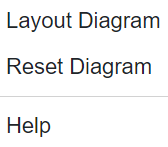Use Case Diagram Modifications & Settings
Below we'll cover the Use Case Diagram's construct editing options and Settings.
| Use Case (Action) Editing Options | A review of editing the Use Case construct. |
| Performer (Asset) Editing Options | A review of editing the Performer construct. |
| System Boundary Editing Options | A review of editing the System Boundary construct. |
| Multiple Use Cases Editing | A review of the editing options when multiple Use Cases are selected. |
| Use Case Diagram Settings | A review of the Use Case Diagram Settings options |
The previous article covers the basics of the constructs of the Use Case Diagram. Below we will cover each constructs' editing options and the Use Case Diagram's settings options.
Use Case (Action) Editing Options
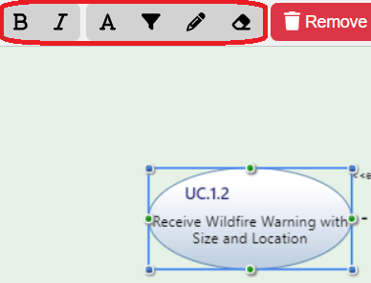
When a Use Case construct is selected, the top toolbar frame changes to provide the following options for users to modify their selected Use Case on the diagram's canvas.
Bold

This option will Bold the name of the Use Case selected on the canvas.
Italicize
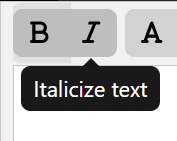
This option will Italicize the name of the Use Case selected on the canvas.
Change Text Fill Color

Using the HTML Color Picker that drops down from the Text Fill Color Option, users can change the text color of the Use Case selected on the canvas by selecting the color associated close to the desired color by simply inputting in the fields the proper codes and numbers.
Change Fill Color
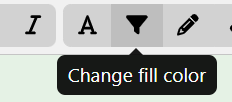
Using the HTML Color Picker that drops down from the Text Fill Color Option, users can change the color of the Use Case selected on the canvas.
Change Stroke/line color

Using the HTML Color Picker that drops down from the Change Line/Stroke Color Option, users can change the color that borders the construct selected on the canvas.
Reset Color back to default
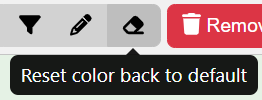
The Reset color back to default option will change the entity selected on the canvas back to the default gray and black colors.
Performer (Asset) Editing Options
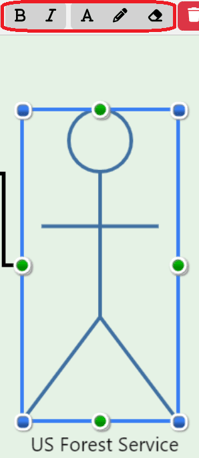
When an Actor construct is selected, the top toolbar frame changes to provide the following options for users to modify their selected Actor on the diagram's canvas.
Bold

This option will Bold the name of the entity Actor selected on the canvas.
Italicize

This option will Italicize the name of the Actor selected on the canvas.
Change Text Fill Color

Using the HTML Color Picker that drops down from the Text Fill Color Option, users can change the text color of the Actor selected on the canvas by selecting the color associated close to the desired color simply inputting in the fields the proper codes and numbers.
Change Fill Color
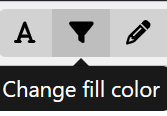
Using the HTML Color Picker that drops down from the Text Fill Color Option, users can change the color of the Actor's name selected on the canvas.
Change Stroke/line color

Using the HTML Color Picker that drops down from the Change Line/Stroke Color Option, users can change the color of the Actor selected on the canvas.
Reset Color back to default
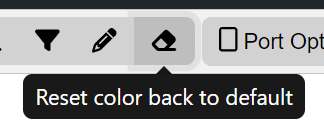
The Reset color back to default option will change the Use Case selected on the canvas back to the default black and blue colors.
System Boundary Editing Options

When a System Boundary construct is selected, the top toolbar frame changes to provide the following options for users to modify their selected System Boundary on the diagram's canvas.
Bold

This option will Bold all the names of the multiple entities selected on the canvas.
Italicize

This option will Italicize all the names of the multiple entities selected on the canvas.
Change Text Fill Color

Using the HTML Color Picker that drops down from the Text Fill Color Option, users can change the text color of the System Boundary on the canvas by selecting the color associated to the desired color by simply inputting in the fields the proper Hex R,G,B codes and numbers.
Change Fill Color

Using the HTML Color Picker that drops down from the Change Fill Color Option, users can change the color of the System Boundary selected on the canvas.
Change Stroke/line color

Using the HTML Color Picker that drops down from the Change Line/Stroke Color Option, users can change the color that borders the System Boundary selected on the canvas.
Reset Color back to default
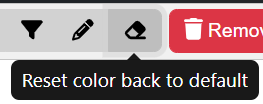
The Reset color back to default option will change the text and filling of the System Boundary selected on the canvas back to the default gray and black colors.
Multiple Use Cases Selected
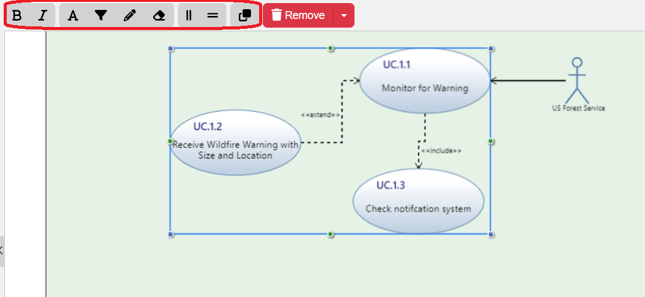
Users may drag their cursor outside of the constructs and a box will appear to select as many multiple Use Cases desired. Many features on the top toolbar will appear upon doing so for the user to utilize. Let's go over each option below.
Bold

This option will Bold all the names of the Use Cases selected on the canvas.
Italicize

This option will Italicize all the names of the Use Cases selected on the canvas.
Change Text Fill Color
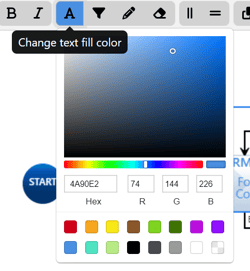
Using the HTML Color Picker that drops down from the Text Fill Color Option, users can change the text color of the Use Cases selected on the canvas by selecting the color associated close to the desired color simply inputting in the fields the proper Hex R,G,B codes and numbers.
Change Fill Color

Using the HTML Color Picker that drops down from the Text Fill Color Option, users can change the color of the constructs of the Use Cases selected on the canvas.
Change Stroke/line color
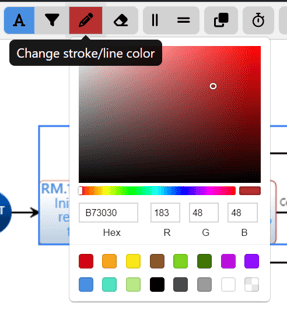
Using the HTML Color Picker that drops down from the Change Line/Stroke Color Option, users can change the color that borders the Use Cases selected on the canvas.
Reset Color back to default
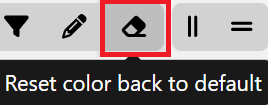
The Reset color back to default option will change the Use Cases selected on the canvas back to the default gray and black colors.
Align Vertically
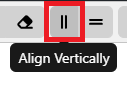
This selection will align the constructs vertically for the multiple entities selected on the canvas. The vertical line will start with the highlighted green Use Case, as shown below.
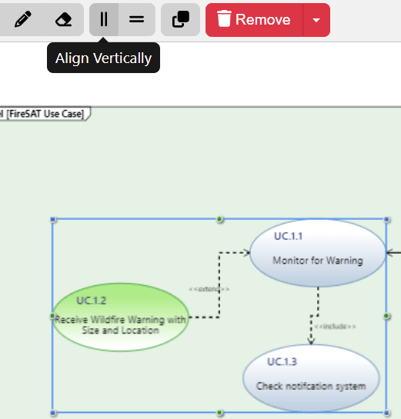
Align Horizontally
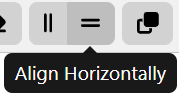
This selection will align the constructs horizontally for the multiple entities selected on the canvas. The horizontal alignment will start with the green highligthed Use Case as shown below.
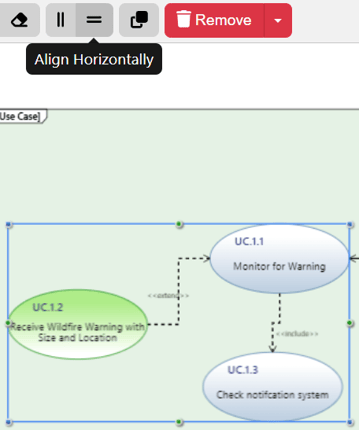
Use Case Diagram Settings

Cross-Project Indicators
![]()
If using Cross-Project Relationships, users may show or hide indicators on the entities from other projects.
SysML Frame Edits
![]()
⚠️The SySML Frame is the green space the model is placed in on the canvas.

The Edit SysML Frame option will bring up the following modal.

Users may select the color of the frame with the  button indicated in green (the green color on the button will change to whatever color a user sets it to). Or bring it back to the defaulted green with the reset option
button indicated in green (the green color on the button will change to whatever color a user sets it to). Or bring it back to the defaulted green with the reset option  .
.
The remaining options on the Modal are in relation to the Diagram Header located at the top left of the SysML frame, example below.
![]()
The changes made to the Select SysML Diagram option refer to the text in the first brackets, known as the Model Element Type (ex. [Profile] in the picture above). Note, the example above is from a Use Case Diagram but shows the Profile option as displayed in the aforementioned Modal image. Therefore it is important to note, users may select a different digram type here, even if you're in a different diagram. The text will change but this option will not change the diagram itself in Innoslate.
The Select Parent option is a dropdown to select a Parent entity for the Model Element Name. This will change the text in between the bracketed texts. In the example above it is the 'Complete ground processing' text.
Hide/Show SysML Frame

Users may use this option to hide (or show, if hidden) the SysML Frame as they wish.
Auto Number, Layout and Reset Diagram
![]()
Users may also Auto Number their diagrams, where a pop up shows up to allow users to use the shown order to determine the number sequence, provide a Prefix or enumerate the single level, as shown below.

Lastly, the final options in the Settings dropdown provides users to reset their diagram from changes and layout the diagram from previous changes.
The very last option, 'Help,' will send users directly to the Help Center page for the Use Case Diagram for convenience.
Frame Fix
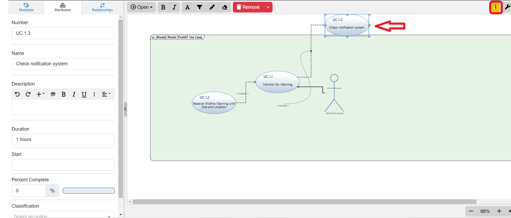
When a construct is ouside of the SysML Frame, Innoslate will detect that and bring up a fix for this as indicaited with the orange exclamation point that appears next to the Settings dropdown.
When selected, a modal pops up to provide users the ability to fix or ignore the issue.

To continue learning about SysML Diagrams, Click Here.
(Next Article: SysML Frame Diagram Header)

